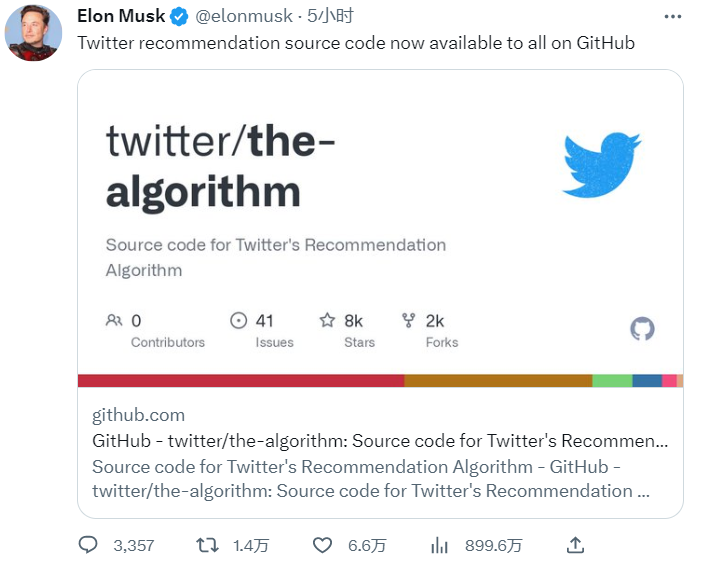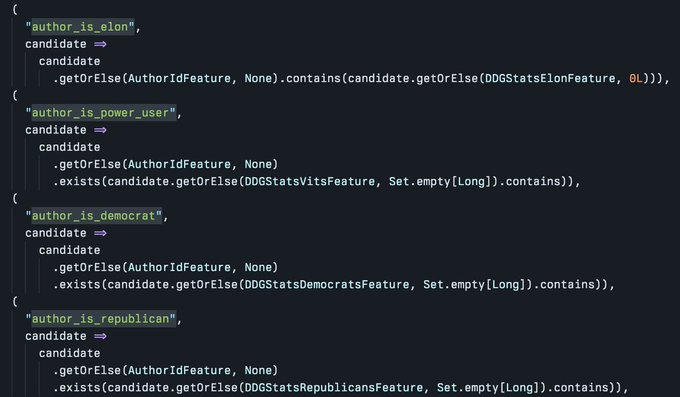On March 31, local time, Musk finally fulfilled his promise to officiallyAnnounceOpen source of the Twitter (Twitter) algorithm.The company has published two repositories on GitHub (main repo, ml repo), which covers much of Twitter’s source code, including the recommendation algorithm, including the mechanism used to control which tweets users see on the For You timeline.and published ablogMore details about Twitter’s algorithm were shared.

“Today marks a new era of transparency for Twitter. We are sharing with the world much of the source code that powers our platform.”
Musk said,Most of the recommendation algorithms are released this time, and the rest will be released gradually; it is hoped that “an independent third party can determine with reasonable accuracy what Twitter may display to users.” However, he also warned that with the open source release, some embarrassing problems may be exposed, “but we will solve them quickly.”In addition he alsoIt added that Twitter will update its recommendation algorithm every 24 to 48 hours based on user suggestions.
The release doesn’t include the code that drives Twitter’s ad recommendations.Twitterexpresswhich aims to be as transparent as possible, excluding code that would compromise user safety or privacy, as well as details that would undermine efforts to prevent child sexual abuse content on the platform.
In the open source release of relevant algorithms Space discussion,Musk said that this open source is to let Twitter align with the famous open source project Linux project, “Even if you don’t agree with something, at least you will know why it is there, and you are not secretly manipulated… .The analogy we crave here is Linux, a great example of an open source operating system… In theory, one could find many vulnerabilities for Linux. In reality, what happens is that the community identifies and fixes these vulnerabilities. …”
twitter in blogDetails what the algorithm considers, ranks, and filters when determining which tweets to display in the For You timeline. According to the introduction, its recommended pipeline consists of three main stages:
- The best tweets are obtained from different recommendation sources in a process called candidate sourcing.
- Each tweet is ranked using a machine learning model.
- Apply heuristics and filters, such as filtering out tweets from users you’ve blocked, NSFW content, and tweets you’ve already seen.
The service responsible for building and delivering the For You timeline is called Home Mixer. Home Mixer is built on top of Product Mixer, Twitter’s custom Scala framework that helps build content feeds. The service acts as a software backbone connecting different candidate sources, scoring functions, heuristics and filters.
The following diagram illustrates the main components used to build the timeline:

in the textSpecific steps in the process are madefurtherexplain.For example first wouldExtract the best from hundreds of millions of tweetsAbout 1500 tweets, the goal is to have about 50% of the tweets in the For You timeline come from users who are already following (i.e. within the network), and 50% of the tweets are from “accounts not yet followed (outside the network)”. ranking”is achieved through a ~48 million parameter neural network that is continuously trained on tweet interactions to optimize active engagement(such as likes, retweets, and replies)”.
Of course, Twitter users don’t see the full 1,500 tweets. They’re filtered based on content restrictions and other criteria and factors the model considers, such as whether tweets have “negative feedback” and whether they’re primarily from the same Twitter user, or from a blocked user.
It is worth mentioning that,Gizmodo points out, the VIP list that Twitter pushes to users does not seem to be made public. Platformer was alsoreported thatTwitter, which has a rotating list of noteworthy users, including YouTuber Mr. Beast and Daily Wire founder Ben Shapiro, monitors changes to its recommendation algorithm by seemingly haphazardly increasing the visibility of these “power users.”
TechCrunch pointed to more evidence that algorithms may treat tweets differently depending on their source. Researcher Jane Manchun Wong pointed out that Twitter’s algorithm specifically flags whether the author of the tweet is Elon Musk, and other tags indicate whether the author is a “power user” and whether they are a Republican or a Democrat.
In response, a Twitter engineer at the Spaces conference that dayexplained, these labels are for metrics only. But Musk said he didn’t know the labels existed before that day and didn’t think they should exist: “There’s absolutely no way people should be divided into Republicans and Democrats, it doesn’t make any sense.”

Related Reading:
#Twitter #algorithm #open #source #News Fast Delivery #Chinese #Open #Source #Technology #Exchange #Community